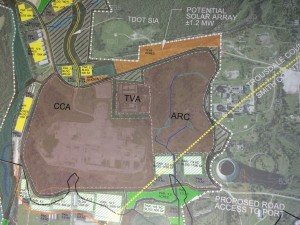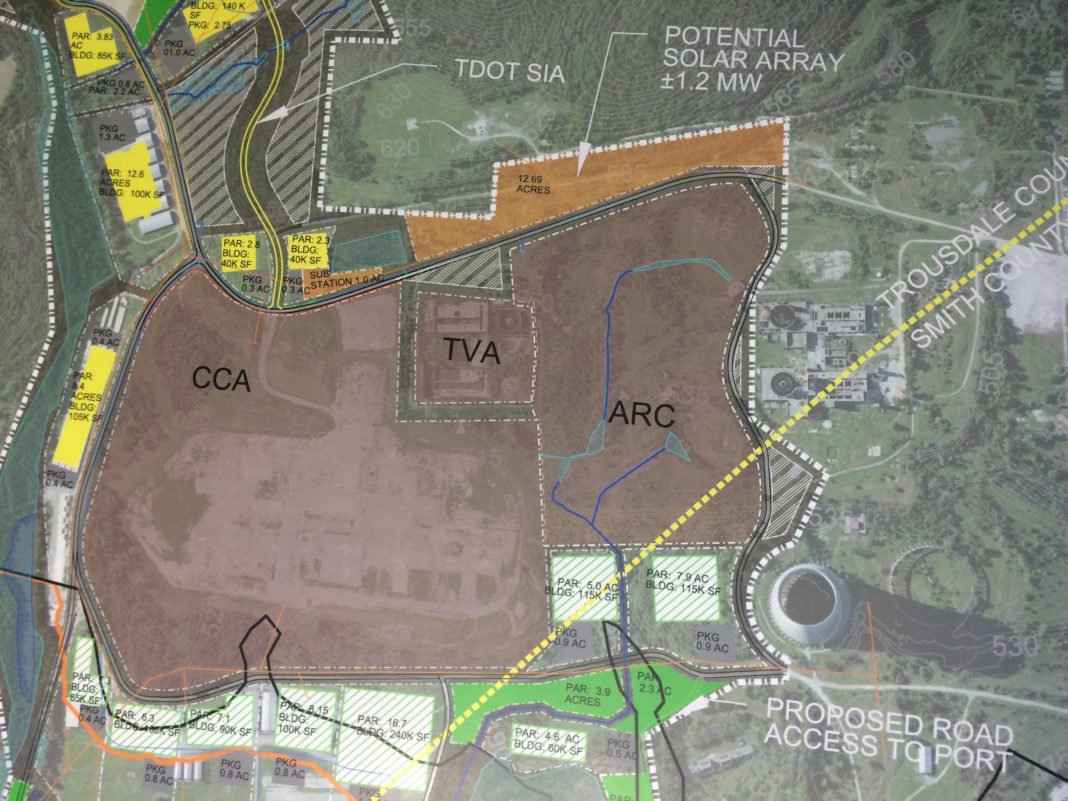
HARTSVILLE – A new automotive supplier – and Trousdale County’s first – is nearing completion on its first phase of construction within the PowerCom Industrial Center, and officials who oversee that property continue to prep the site – and others within a five-county region – for further commercial development.
PowerCom, a 440-acre industrial park and one-time world’s largest Tennessee Valley Authority (TVA) nuclear site, has been a moving target, but, these days, it’s one on the up-and-up: V&C Manufacturing/Christy’s, a maker of industrial adhesives, and Mueller Refrigeration both celebrated recent expansions; Corrections Corporation of America (CCA) is running full steam ahead at its 2,552-bed medium-security male prison; and moves are being made to make even more land shovel-ready.
While ARC Automotive Inc., the newest tenant, is making a smaller-scale investment – $3 million and 66 jobs – it puts Trousdale County on the map in automotive and adds to Tennessee’s tally. The state now boosts more than 900 automotive manufacturers and suppliers.
ARC, specifically, makes automotive airbag inflators. It expects to begin production in May.
“We’ve got a lot of positive things going on,” said Charly Lyons, executive director of the Four Lake Regional Industrial Development Authority, an economic agency that focuses on the Macon, Smith, Sumner, Wilson and Trousdale County areas, and owner of the PowerCom site. His group is even phasing in a new name, the Tennessee Central Economic Authority, to better market itself internally and externally.
“This is a first step for us,” he said. “Trousdale County, as far as I know, didn’t have anyone serving the automotive industry, and there’s a Nissan plant in Smyrna, a GM plant in Spring Hill…they have a tendency to work in clusters sometimes.”
Scarecrow lands
ARC, or Project Scarecrow, announced its Hartsville plans in May 2014. The project’s start date was since delayed due to changing market conditions – and after a myriad of recalls and safety concerns, a move to develop alternative propellants, the material used to kickstart the chemical reaction needed to fill an airbag. But construction is now nearly complete on the first of two buildings in a multi-phase plan. Cookeville’s J&S Construction and Bouton Engineering were contracted to provide initial professional services.
ARC chose PowerCom because it was strategically located between existing sites in Knoxville and Morgantown, Kentucky. The company also considered Arizona and Virginia in the U.S.

“We want build a legacy in Hartsville,” said Tim Frazier, who joined the ARC team
in January and will serve as plant manager. “My previous experience manufacturing propellants and explosives was in facility that’s been around since the beginning of World War II, so it’s in their DNA.We want to get to that point here… where we’re recognized as a good employer, a good community citizen, involved in helping make the community better.”
He said they will test a new propellant at the Hartsville site. How quickly ARC expands depends on further capital and equipment, much of which is built-to-order. They’re immediately staffing around four to 10 process associates and two to three maintenance technicians. It could take eight to 10 months to ramp up fully.
“We’ll start with those two buildings, where we’ll make the initial propellants, send them off for testing and to customers so we can make sure we’re meeting their expectations, and then it’s a pretty rapid growth curve from there,” Frazier said. “We’ll look to maximize our current throughput with the buildings and equipment we have, but kicking in phase two, building more buildings, procuring more equipment, staffing up more people.”
Lyons said their site selection was unique in at least one way. The property – which measures 50 acres – has a number of features that other prospects may have considered a challenge – wetlands, for example, and several large, concrete structures once used by TVA, mothballed buildings that’d be cost prohibitive to remove.
But ARC will use those as an advantage. The very nature of the production necessitates buffer zones.
“They looked at this site differently,” Lyons said. “They needed a lot of land, and land can be expensive, so they’re using the environment to their advantage. They have a design that uses wetlands, and the stream, and the buildings as barriers and buffers.”
PowerCom continued
Together, CCA and ARC consume more than a third of PowerCom property – so work is ongoing to make sure more sites are shovel ready, removing deficient structures and initiating site clean up. Lyons said Macon and Smith counties, in particular, are also in the process of looking for land. Four Lake/Tennessee Central has completed a feasibility study to gauge future use of an existing Cumberland River terminal dock. Past improvements included dual-feed power and waterline extensions, natural gas lines, security fencing and sewer.
“We’re doing everything we can to be prepared,” Lyons said.
And, another key, hopefully for 2016, construction on a new industrial access road within PowerCom. Tennessee Central has committed $600,000 for engineering and construction, and TDOT’s share exceeds $1.6 million.
“The existing roads were primarily built all by TVA, and those roads were built mainly for construction and internal access,” Lyons said. “They weren’t built for public traffic.”
Lyons said a contract should be let in June. TDOT has already staked the road’s centerlines, etc. He’s hoping construction could start soon after, although that’s yet to be determined.









